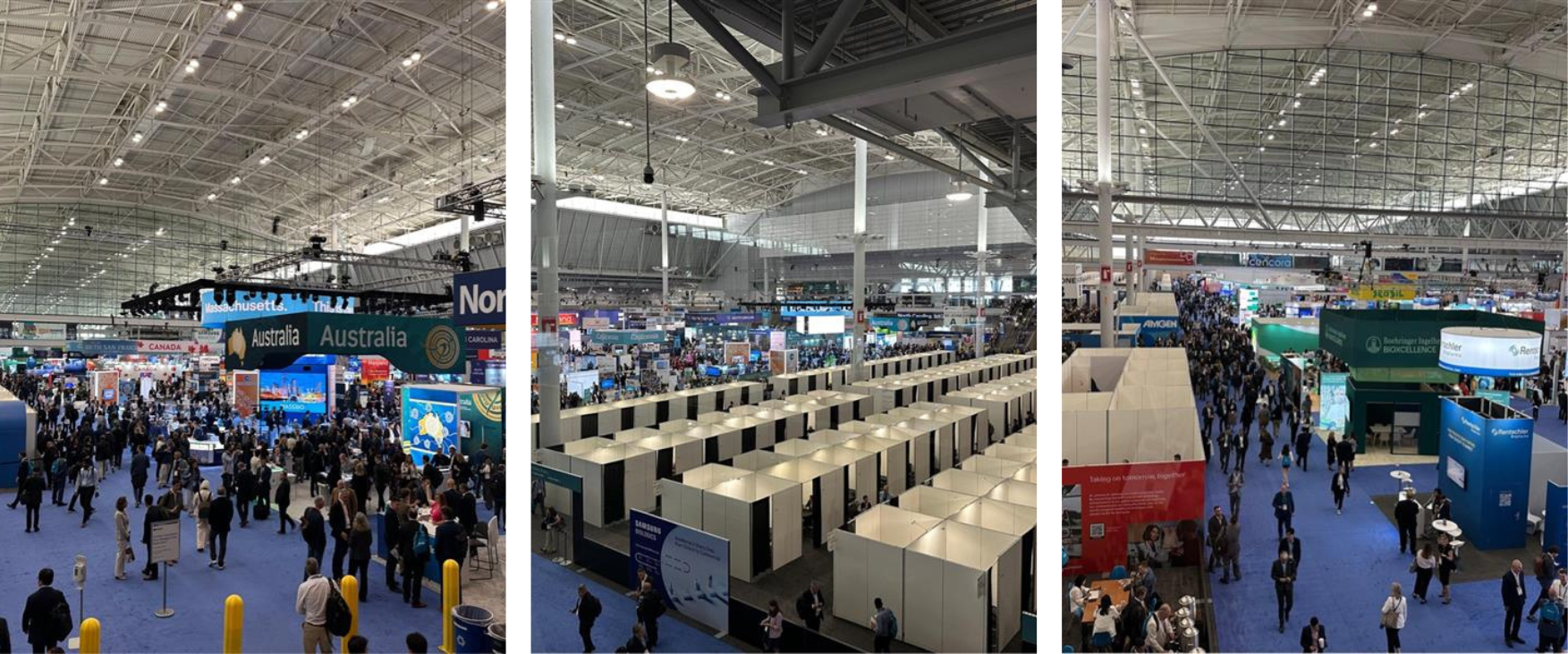I’m always keen to stay up to date with the latest scientific developments. On a recent business trip to the U.S., I had the chance to explore some really exciting new advancements first hand.
One moment that really stood out to me was a talk on how AI is being used in cutting edge biotech research. Hearing how it’s accelerating scientific breakthroughs – and having it explained so clearly by someone at the forefront of AI and machine learning in the Lifesciences industry – was incredibly eye-opening. It made the future of research feel both exciting and within reach.
Thanks to Dr Azim Dehghani, Principal AI/ML Scientist at J&J Innovative Medicine for his contributions to this article.
Key AI Trends from the Boston Paris Biotechnology Summit
Dr. Azim Dehghani Amirabad’s presentation at the 9th Boston Paris Biotechnology Summit provided crucial insights into how AI is reshaping biotechnology. As Principal AI/ML Scientist at J&J Innovative Medicine, Dr. Azim Dehghani brings a unique perspective rooted in a background spanning computer science and computational biology. He completed his PhD research at the Max Planck Institute for Informatics and postdoctoral training at MIT Computer Science and Artificial Intelligence Laboratory (CSAIL), positioning him at the forefront of applying advanced AI to Biotech/Pharma.
The Four Waves of AI in Biotechnology
Dr. Azim Dehghani described how biotechnology has experienced four distinct waves of AI innovation, each building on the last to unlock new capabilities across the R&D pipeline:
✅Wave 1 (Pre-2015): Predictive/Analytical AI with Small Models
Before the deep learning revolution, most AI models in biotech were relatively small and focused on analytical tasks—forecasting outcomes, identifying biomarkers, and performing initial target prioritization using limited data. While valuable, these early models offered narrow insights and lacked the ability to handle complex, high-dimensional biological information.
✅Wave 2 (2015–2021): The Race to Scale with Transformers
The introduction of transformer architectures in 2017 marked a major turning point. Large models like BERT, BioBERT, and AlphaFold dramatically expanded AI’s capabilities, enabling breakthroughs in tasks such as protein structure prediction, biological text mining, and understanding complex relationships across biological data. This era was defined by the rapid scaling of model size and training data to unlock new levels of performance.
✅Wave 3 (2022+): Generative AI and Domain-Specific Foundation Models
Better, more accessible generative models have accelerated generative biology across multiple scales, enabling advances in protein engineering, cell line optimization, RNA and DNA design, and small molecule generation. Protein language models and text-to-molecule systems have opened exploration of unprecedented chemical and biological spaces, driving faster iteration in designing new biological entities.
✅Wave 4 (2024+): Agentic AI and Multi-Agent Systems
Today’s frontier is agentic AI, where systems don’t just predict or generate—they plan, act, adapt, and collaborate autonomously. Multi-agent frameworks scale intelligent decision-making across the entire discovery and development process, enabling more coordinated, adaptive, and efficient R&D.
This progression highlights how AI has evolved from simple analytics to autonomous, adaptable systems that enable unprecedented advances in biotech.
Foundational Models: Powering Multimodal AI in Biology
Dr. Azim Dehghani explained that foundational models are large, pre-trained AI systems designed to generalize across tasks and data types, serving as versatile backbones for modern AI strategies. They reduce the need to build separate models for every application, dramatically accelerating innovation.
In biotechnology, foundational models now exist for nearly every key biological modality:
● Protein Language Models: Enable structure prediction, variant effect estimation, and novel protein design.
● DNA & RNA Models: Learn genomic and regulatory patterns, improving variant interpretation and functional genomics.
● Small Molecule Models: Represent chemical structures for property prediction, virtual screening, and generative molecule design.
Major technology companies like Meta and NVIDIA have entered this space, developing large-scale biological models to accelerate discovery and unlock strategic advantages.
Why Foundational Models Matter
Foundational models provide a flexible, reusable base that can be adopted for a wide range of downstream tasks, from predicting protein functions to classifying genomic variants or assessing drug properties. Their generative capabilities enable innovation in biological design problems, such as creating novel protein sequences, optimized RNA constructs, or entirely new small molecules—accelerating discovery beyond traditional methods.
Agentic AI: Scaling Intelligence Across the Board
Building on the infrastructure established by generative AI and foundational models, agentic AI systems take things a step further by autonomously planning analyses, executing tasks, learning from outcomes, and refining hypotheses—effectively functioning as digital scientists.
While generative AI and foundational models can be thought of as the core infrastructure that equips AI systems with the knowledge and flexibility needed to operate across diverse data and tasks, agentic AI serves as the scaling layer, orchestrating these capabilities to automate complex research workflows end-to-end.
By coordinating multi-step analyses, adapting in real-time, and iteratively improving hypotheses based on new evidence, agentic AI systems enable organizations to scale intelligent decision-making throughout R&D. This unlocks faster timelines, higher-quality results, and the discovery of novel insights that would be impractical or impossible to achieve manually.
AI as a Strategic Partner to Augment Human Capabilities
Dr. Azim Dehghani emphasized that AI has evolved from a passive tool into a strategic partner that augments human expertise. Advanced AI can:
● Identify unexpected patterns and propose alternative hypotheses.
● Suggest new research directions based on fresh data.
● Anticipate potential issues before they escalate into bottlenecks.
By combining human creativity and contextual understanding with AI’s speed, scalability, and pattern recognition, organizations can make smarter, faster, and more innovative decisions, ultimately enhancing every stage of R&D.
Transforming the Entire Drug Discovery and Development Pipeline
The integration of predictive, generative, foundational, and agentic AI technologies is redefining every stage of the drug discovery and development pipeline:
● Target Discovery: AI uncovers novel disease pathways and identifies high-potential targets.
● Drug Design: Generative models create optimized molecules with better predicted properties.
● Preclinical Development: AI forecasts safety and efficacy risks earlier, reducing costly failures.
● Clinical Operations: AI improves trial design, identifies optimal patient populations, and streamlines protocols.
● Manufacturing & CMC:AI enhances formulation, process optimization, and scalability, driving efficiency from lab to production.
This comprehensive impact makes AI a catalyst for accelerating timelines, reducing costs, and unlocking innovative solutions across the entire pharmaceutical lifecycle.
What Winners Do Differently
Dr. Azim Dehghani highlighted that organizations leading in AI adoption don’t simply experiment with isolated pilots—they pursue strategic, organization-wide transformation. These successful companies:
Drive End-to-End Integration: Embed AI across the full value chain, aligning it with both scientific and commercial objectives.
Invest in People and Culture: Upskill teams and foster a culture that embraces AI-driven insights.
Redesign Workflows: Reimagine processes to fully leverage automation, multimodal data, and agentic reasoning.
Measure What Matters: Define meaningful ROI and metrics that capture both AI performance and business outcomes.
Empower Human-AI Co-Creation: Build trust between experts and AI systems, enabling creative, iterative refinement of research directions.
By adopting these strategies, organizations position themselves to lead in an AI-native future where human and machine intelligence work seamlessly together.
Implications for the Digital Health Industry
The biotechnology trends outlined by Dr. Azim Dehghani have significant implications for the broader digital health ecosystem. Healthcare technology companies can learn from biotech’s systematic, phased approach to AI integration. The progression from predictive to generative to agentic AI, as highlighted in his talk, provides a roadmap for other digital health organizations seeking to build effective AI strategies.
The emphasis on foundational models and multimodal integration suggests digital health companies should invest in flexible, adaptable AI systems rather than narrow, single-purpose applications. Such systems enable richer insights by connecting diverse data sources—mirroring how multimodal models in biotech accelerate discovery.
Most importantly, the concept of becoming an AI-native organization, discussed throughout Dr. Azim Dehghani’s presentation, applies well beyond biotechnology. Digital health companies that embed AI into their core operations—rather than retrofitting AI features onto existing products—are more likely to gain significant, sustained competitive advantages.
Preparing for an AI-Driven Future
As emphasized in Dr. Azim Dehghani’s insights, recent biotechnology conferences make one point clear: AI is not simply changing how organizations operate—it is rapidly becoming fundamental to competitive success.
Organizations that see this transformation as optional may find themselves increasingly at a disadvantage, as AI-native competitors demonstrate superior speed, discovery rates, and operational efficiency across healthcare and life sciences.
The good news is that companies don’t need to undergo immediate, wholesale change. They can begin with focused AI applications, gradually building expertise and expanding integration as they demonstrate success and develop internal capabilities.
However, strategic planning and foundational investments must start now. The biotechnology industry’s experience, as highlighted during Dr. Azim Dehghani’s talk, shows that effective AI integration requires time, thoughtful design, and sustained commitment.
Digital health companies that start building AI-native capabilities today will be best positioned to capitalize on future opportunities and navigate the increasingly AI-driven healthcare landscape.
The question is no longer whether AI will transform digital health—recent developments show that transformation is already underway. The real question is whether individual organizations will lead that transformation or struggle to keep pace with competitors that embrace AI as a strategic partner, rather than merely another tool.
If you are passionate about sciences and its latest breakthroughs, as I am – or if you would be interested in contributing to our Lifesciences Blog Series – I’d love to hear from you. Judith Moffett, Business Development Director at Cpl Group, a leading Lifesciences Staffing and Consultancy Organisation, who specialise in Permanent, Temp, Contract recruitment, RPO, MSP and BPO.
[email protected]
.png)
.png)